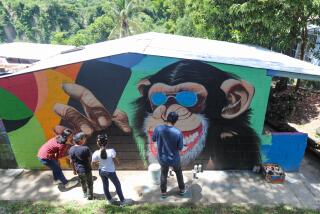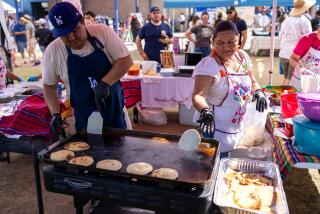Long, Hot Summer After Quake
SANTIAGO DE MARIA, El Salvador — Santos Guerara’s house doesn’t look like much. The walls are plain gray concrete blocks. The floors are still dirt. And there are only three rooms.
But she is the envy of her neighbors.
“It’s cool in here. We can sleep at night,” Guerara, 74, said as she stood outside her home in this hilly coffee region, cooking tamales over a smoky fire to sell at market.
After back-to-back earthquakes last winter damaged or destroyed half the country’s homes, Guerara and a few thousand other lucky Salvadorans received help from Catholic Relief Services and other charities, which built new houses--often better than the ones lost.
Everybody else got “microwaves”--the none-too-endearing term Salvadorans use for the temporary tin shelters the government erected in the quakes’ aftermath.
The shelters, which can heat up to 120 degrees in the tropical sun, are supposed to be replaced someday by permanent homes. But with no funding in sight, more than 175,000 Salvadoran families are facing a long, hot summer and an uncertain future.
“It’s like an oven,” said Angela Torres, a 65-year-old widow who lives in one of the tin shelters less than a mile from Guerara’s concrete dwelling. “I feel like I’m cooking.”
To be fair, the impoverished Salvadoran government faced a nearly impossible task in the days after the quakes. Thousands were homeless, and the country’s rainy season was fast approaching. While aid groups were pouring into the country, their bells-and-whistles rebuilding programs covered only a fraction of the need.
The tin shelters--even government officials occasionally slip and call them “microwaves”--were the government’s answer. They were cheap ($195 apiece), easy to build (nails and a hammer sufficed) and provided basic shelter (172 square feet).
The government had to scour the globe for the necessary amount of wood and tin. It bought enough sheets of corrugated tin to stretch from El Salvador to Argentina. The 2-by-4s would reach Australia.
In the end, the military, government and aid groups managed to erect more than 175,000 temporary shelters in less than four months, an amazing logistical feat in a country with a shattered infrastructure and economy.
The government makes no claim that the tin shelters are adequate long-term housing. But it takes pride in having managed to provide at least some shelter to nearly all those left homeless by the quake.
“We realize they’re not dignified housing,” said Miguel Angel Siman, a presidential advisor who heads the government’s rebuilding effort. “They’re not permanent. Clearly they’re temporary.”
It’s that last claim that worries Salvadorans. The government estimates total damage from the quake at $2 billion. About half that amount is in hand, in the form of loans or donations. The rest is nowhere in sight.
“If we don’t get the rest of the money, we can’t build [permanent] houses,” Siman said. “I don’t want to sound cold, but the problem of housing is not a public problem, it’s a private problem. It’s a political problem.”
The housing contrasts are vivid here in Santiago de Maria, a small town of adobe homes and steep streets.
Like many other small towns throughout the country, Santiago de Maria was nearly flattened by the quakes in January and February. Within days of the first quake, a local church had contacted Catholic Relief Services seeking help to rebuild. The agency responded by launching a plan to build about 400 homes in the area and 600 elsewhere in the country.
The aid agency saw the quake as an opportunity to rebuild not only homes but also lives.
“The real disaster here is the extreme poverty,” said Ellen Calmus, a spokeswoman for Catholic Relief Services. “For reconstruction to work in the long term, you have to do more than build strong, decent housing. You have to help people break out of the cycle of poverty.”
The agency-built homes, small gray concrete blocks wedged between the white and yellow and lavender pastels of the traditional mud-and-stick homes of Santiago de Maria, stand in marked contrast to the sprawling warren of about 250 tin shelters built under the government’s program.
Hastily raised by relief workers on the grounds of an abandoned coffee-processing factory, the site seems a metaphor of how not to build a city, a nightmarish cross between Calcutta’s slums and Crete’s labyrinths, where hundreds of tin shelters smash against each other with neither toilets nor lighting.
Alleys about 3 feet wide wind through the settlement. Because the homes are on a slope, water gushes in when it rains. Built of nothing more than corrugated tin and 2-by-4s, the shelters can be 20 to 25 degrees hotter than the outside air, according to a thermometer carried on a recent sweltering visit.
Torres, who has lived in her tin shelter since shortly after the February quake, said it can get so hot that she has burned herself by touching the walls.
But worse than the living conditions is the uncertainty. Like everyone else in the community, Torres had to sign a paper agreeing to leave the settlement as soon as the government demands it.
And while she hopes that the government will return to build her a permanent house, she said she isn’t sure that it will happen.
“They said they were going to build it. I just don’t know if it’s true or not,” Torres said.
Just a few houses away from Torres, Maria Luisa Castro sat outside her “little hut,” as she called it, rubbing alcohol on her 2-year-old son’s back.
Clad only in diapers, the curly-haired boy was covered in dozens of mosquito bites. Five or six children had come down with the mosquito-borne illness dengue fever in the last few weeks, Castro said, and one had almost died. As Castro spoke, a teenage girl sat nearby with a vacant stare, furiously scratching at one of her hands, bloody and covered with sores.
“We don’t have any medicine here. All the children are suffering,” Castro said. “We don’t know what’s going to happen. We’re waiting to see.”
Still, Castro said she was better off in her tin shelter than her old home. Like many of those interviewed, Castro lived before the earthquake in a boarding house, sharing cramped quarters with other families.
Now, at least, she has her own space, one that seems safer than the one-room apartment that nearly collapsed during the earthquake. Plus, it was free.
“We’re better off than before because here, we don’t have to pay anything,” she said.
More to Read
Sign up for Essential California
The most important California stories and recommendations in your inbox every morning.
You may occasionally receive promotional content from the Los Angeles Times.










